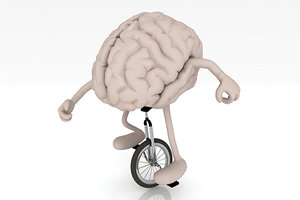It is well-known that loss of balance in the aging population is a key concern when it comes to the risk of falls and subsequent injuries, such as fractures. However, modern-day neuroscience research continues to show the influence postural stability and balance have on brain health and function. From neurodevelopment to neurodegenerative disorders, sensory input from the body into the brain is critical for optimal functional connectivity within the master regulator responsible for the neurobiology of disease: the brain!
Balance & the Neurobiology of Dis-Ease
When it comes to balance, the visual, vestibular and proprioceptive systems are driving the show. These sensory systems provide the brain with the "status" of where the body is in space and how to move about (safely) over various terrains. This allows us to move about different environments with confidence in a calm, cool and collected manner.
If the brain is lacking this sensory input, a person will have poor body positional awareness which can create a chronic, low-lying state of anxiety when moving through space. Not only can this limit the amount of movement a person gets within a given day (and we know that movement is a key essential for brain and body health), but this chronic anxiety also can dysregulate the hypothalamic-pituitary-adrenal-thyroid-gonadal (HPATG) axis and contribute to a barrage of metabolic and other health consequences.
 In fact, dysregulation of the HPATG axis is being referred to as the developmental origins of disease (DOD): physical, mental and emotional disease.
In fact, dysregulation of the HPATG axis is being referred to as the developmental origins of disease (DOD): physical, mental and emotional disease.
Dysregulation within the HPATG axis is the foundation of metabolic disorders such as diabetes. Recent evidence suggests falls are a major complication of diabetes in elderly patients, leading to disability and preventable death.1 Large population-based studies show that patients with diabetes are more likely to have vestibular loss.
Patients with diabetes also have a significantly greater risk for falling due to complications affecting the sensory systems required for balance.2
Balance disorders and vestibular function have also been linked with asthma. Jacob, et al.,3 proposed that individuals with anxiety disorders may have a subclinical deficiency of vestibular function that is enough to cause discomfort in situations in which there is a lack of visual or kinesthetic information for proper balance. This clinical picture was described as "space and motion discomfort" (SMD) and is a condition that can trigger emotional symptoms in patients.
A recent meta-analysis indicated that anxiety disorders were prevalent in almost 23 percent of adolescents with asthma, as compared to 7-8 percent prevalence in the general youth population. Adolescents with asthma also had higher incidence of and likelihood to develop major depression compared to controls.
Other survey studies have indicated that 16.3-35 percent of participants met criteria for anxiety or depressive disorder diagnoses, and these conditions were more common in people with worse asthma symptoms.4
In a study investigating balance control in asthmatic patients, researchers found that asthmatic individuals presented a greater area for the center of pressure (CoP) displacement under somatosensory perturbations and a higher velocity in the forward–backward direction when vestibular information only was made available. The data suggests balance needs to be evaluated in asthmatic patients.5
Supporting Balance for a Better Brain
Disturbances from stretching reflexes of the ankle will compromise somatosensory input into the brain, leading to conflicting afferent signals. This "mismatch" of sensory information stresses the adaptive responses of the central nervous system, which can lead to conditions such as balance disorders, metabolic dysfunction and anxiety.
Custom foot orthoses that support all three arches of the feet are known to improve postural stability via a somatosensory or biomechanical effect. The use of footwear with the proper features can be an appropriate intervention in order to increase balance in the older population and reduce falls.6
However, in the realm of systems biology, maladaptive responses within the central nervous system are the basis of most modern-day diseases. Therefore, a reasonable working theory would be that if one stabilizes the foundation, the feet and ankles, the brain will be better able to process and adapt to its environment; allowing for better homeostatic balance across all ages and all stages in life.
References
- Li J, Jiang J, Zhang Y, et al. Impairment of vestibular function and balance control in patients with Type 2 diabetes. Audiol Neurootol, 2019;24(3):154-160.
- Piker EG, Romero DJ. Diabetes and the vestibular system. Semin Hear, 2019 Nov;40(4):300-307.
- Jacob RG, Woody SR, Clark DB, et al. Discomfort with space and motion: A possible marker of vestibular dysfunction assessed by the situational characteristics questionnaire. J Psychopathol Behav Assess, 1993;15:299-324.
- Caulfield JI. Anxiety, depression, and asthma: New perspectives and approaches for psychoneuroimmunology research. Brain Behav Immun Health, 2021;18:100360.
- Cunha ÂG, Nunes MP, Ramos RT, et al. Balance disturbances in asthmatic patients. J Asthma, 2013 Apr;50(3):282-6.
- Aboutorabi A, Bahramizadeh M, Arazpour M, et al. A systematic review of the effect of foot orthoses and shoe characteristics on balance in healthy older subjects. Prosthet Orthot Int, 2016 Apr;40(2):170-81.
Dr. Monika Buerger, a 1991 graduate of Life Chiropractic College West, is the owner of Eagle Canyon Wellness & Sensory Development Center in Ammon, Idaho. She is a teacher, international lecturer, author, and the founder of Intersect4Life Educational Seminars and developingMINDS certification program in childhood and adolescent neurodevelopment. For more information, visit www.intersect4life.com and www.devmindsu.com.




